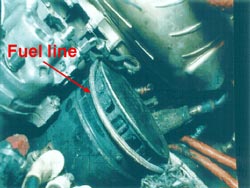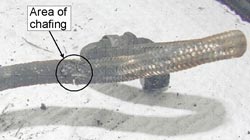In-Flight Engine Fire / Forced Landing
Campbell Helicopters Ltd.
Bell 205A-1 Helicopter C-FMQN
Tobin Lake, Saskatchewan
The Transportation Safety Board of Canada (TSB) investigated this occurrence for the purpose of advancing transportation safety. It is not the function of the Board to assign fault or determine civil or criminal liability. This report is not created for use in the context of legal, disciplinary or other proceedings. See Ownership and use of content. Masculine pronouns and position titles may be used to signify all genders to comply with the Canadian Transportation Accident Investigation and Safety Board Act (S.C. 1989, c. 3).
Summary
A Bell 205A-1 helicopter, registration C-FMQN, serial number 30082, was engaged in forest fire suppression activities and was bucketing the southwest corner of a fire. The pilot had already made several drops on the day of the occurrence. While the helicopter was approximately 250 feet above ground level en route to Tobin Lake, Saskatchewan, to pick up a bucket of water, the engine fire warning light came on and the pilot saw smoke coming out of the engine cowling. Seconds later, the pilot noted that the master caution light and the engine chip detector had illuminated, and the oil pressure was decreasing to zero. The pilot elected to land the helicopter in a farmer's field. During the descent, the pilot kept power on the engine and discharged the fire bottle, but the fire did not extinguish. Immediately after the landing, the pilot shut the fuel off and, with the second crew member, evacuated the aircraft. Another helicopter working the same fire dropped a bucket of water and extinguished a majority of the fire. The rest of the fire was extinguished using a fire truck that arrived on the site. The helicopter sustained substantial damage to the engine, engine bay, and baggage compartment. The crew members were not injured.
Factual information
The accident occurred during daylight hours at about 2000 central standard timeFootnote 1. The observed weather at 2000 at Prince Albert, 67 miles southwest of Tobin Lake, was as follows: winds 200 degrees at 13 knots, visibility 15 statute miles, scattered clouds at 6000 feet, broken clouds at 14 000 feet, temperature 18°C, dew point 8°C, and altimeter setting 29.92 inches of mercury. Similar conditions existed at Tobin Lake at the time of the accident, except that the wind was from the east at 5 to 10 knots.
The pilot of the helicopter held a valid commercial helicopter pilot licence and was properly trained and qualified for the intended flight.
The helicopter was operated by Campbell Helicopters Ltd., and was on contract to the Province of Saskatchewan to help fight forest fires in the area. The helicopter underwent some maintenance, including major repairs to the engine deck and firewall, approximately six weeks before the accident. The aircraft had flown 19.9 hours since the last 100-hour inspection. At 13.5 flight hours prior to the occurrence, the starter/generator had been removed to accommodate the replacement of the starter/generator seal, then re-installed.
Inspection of the engine revealed extensive damage to the engine and surrounding engine bay area. The blown fire bottle plug and fire retardant material found in the engine bay indicated that the fire retardant had been discharged. The variable inlet guide vane actuator (VIGVA) hose, which provides fuel pressure to open the variable guide vanes, was found pinched between the top of the starter/generator and the impeller housing assembly (see Photo 1).
Further inspection of the pinched fuel hose revealed a hole through the steel braiding and inner lining (see Photo 2). Inspection of three similar helicopters, found that both lines coming from the VIGVA were routed behind and underneath the starter/generator, clear of any interference.The fire was confined to the engine bay and the baggage compartment, which is directly underneath the engine bay deck. All engine indication electrical harnesses and interfaces were destroyed by the fire. The cap that houses the cooling fan on the starter generator had separated from the generator housing. The cap was retained over the cooling fan by the pinched fuel line. The cooling fan blades were missing. The cap is normally held in place by six countersunk screws on the rear of the starter/generator.
Removal of the starter/generator revealed that the hold-down nut at the 12 o'clock position was missing, and the hold-down nut at the 10 o'clock position was backed off approximately 0.125 inch. It was reported that the retaining nut at the 12 o'clock position had been intentionally left off for ease of starter/generator removal and installation. The end of the starter/generator shaft showed signs of peening, indicating misalignment. The commutator and brushes of the starter/generator produce heat and sparks during normal operation.
The starter/generator and fuel hose assembly were forwarded to the TSB Engineering Branch Laboratory for analysis. The analysis revealed soot on the shoulders of the hold-down nut receptacles, on the attach flange of the starter/generator, at the 12, 10 and 8 o'clock positions. The starter/generator is normally held in place by six hold-down nuts. Analysis of the cooling fan indicated that the fan blades had been abraded away. No indication of a catastrophic failure of the fan blades was found. Analysis of the fuel hose indicates that the steel braid strands failed as a result of chafing.
Analysis
Fire damage to the engine indication electrical harness and interface disrupted the electrical system and resulted in the illumination of the master warning caution light, chip detector light, and caused the oil pressure indication to drop to zero.
The soot found on the shoulders of the 12, 10 and 8 o'clock hold-down nut receptacles on the attach flange of the starter/generator indicates that these three hold-down nuts were not fastened during the fire. Without these hold-down nuts being properly tightened, there would be insufficient clamping force holding the starter/generator in place, and it would vibrate. The vibration chafed a hole through the fuel line, allowing fuel to dribble past the cooling fan cap of the starter/generator and onto the commutator. It is likely that heat generated by the starter/generator and sparks emitted by the commutator and brushes acted as an ignition source, resulting in a fire. With power on, the engine produced fuel pressure in the chafed fuel line that kept feeding the fire. It was not determined how the fuel line became trapped between the top of the starter/generator and the diffuser housing.
It was considered likely that the vibration of the starter generator also induced the cooling fan cap screws to back out. After the cap separated, it was retained over the cooling fan blades by the pinched fuel line, resulting in abrasion of the cooling fan. The abrasion of the cooling fan did not contribute to the failure of the fuel line.
The fire bottle was discharged during the descent with engine power on. It is considered likely that the fire was momentarily suppressed, but because of the constant supply of fuel and ignition, it re-ignited after the retardant was spent.
The following TSB Engineering Lab Report was completed:
- LP 104/02 – Starter/generator and Fuel Hose Analysis
Findings
Findings as to causes and contributing factors
- The fuel line to the VIGVA was pinched between the top of the starter/generator cooling fan housing and the diffuser housing.
- Three starter/generator hold-down nuts at the 12, 10 and 8 o'clock positions were not fastened, allowing the starter/generator to vibrate.
- Because the fuel line was pinched against the vibrating starter/generator, it chafed through, allowing fuel to enter the starter/generator, which resulted in an engine fire.
Findings as to risk
- The hold-down nut at the 12 o'clock position was left off for ease of starter/generator removal and installation.
Other findings
- The vibration of the starter/generator induced the separation of the cooling fan cap, resulting in the abrasion of the cooling fan blades.
Safety action
Transport Canada is conducting a review of the applicable Bell 205A-1 instructions for continuing airworthiness to determine if action is necessary regarding the instructions for the installation of starter/generators and fuel lines.
This report concludes the Transportation Safety Board's investigation into this occurrence. Consequently, the Board authorized the release of this report on .

